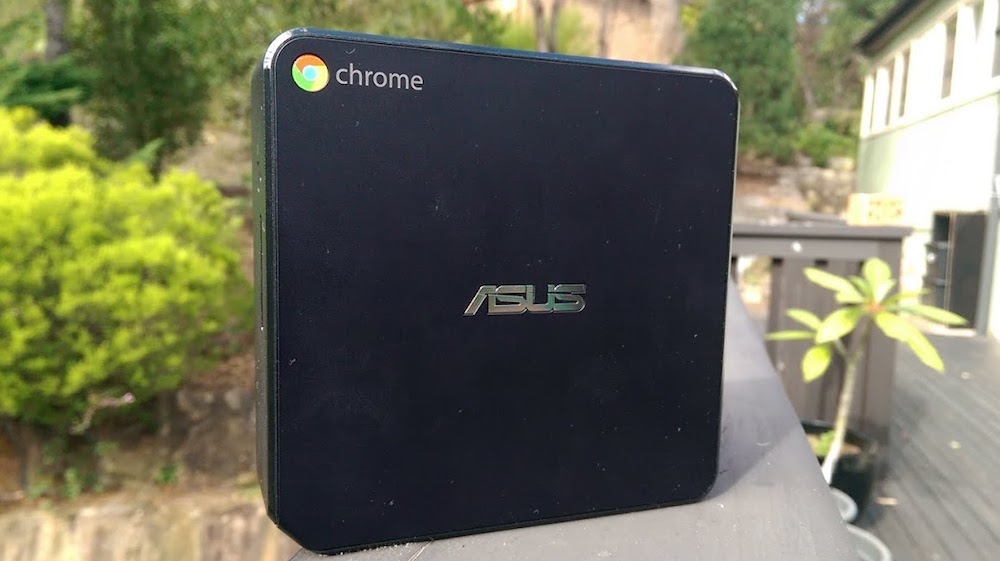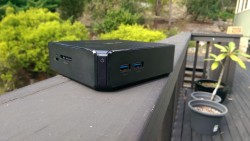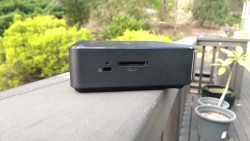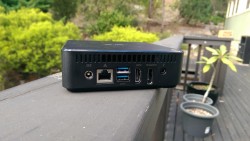
We’ve reviewed quite a few Chromebooks on Ausdroid now, and while the hardware generally differs a little bit, in the sense of keyboard quality, screen quality and battery life, they’re generally very similar; screen resolution is invariably the same, and ChromeOS is ChromeOS regardless of the platform it’s running on. In short, within a reasonable margin of error, if you’ve used one ChromeOS device, you’ve used them all.
However, with very few exceptions, ChromeOS devices have thus far been of the laptop and notebook variety. Early in the piece there were some desktop variants announced, but they certainly weren’t what you’d call available in Australia. Generally they were restricted to Educational and Corporate channels, and frankly, we don’t know how successful they’ve been.
More recently, and particularly at CES 2014, we saw the announcement of a few more options for ChromeOS. ASUS announced some Chromeboxes, like the one pictured above, and LG announced the Chromebase, an iMac-esque device running Chrome in an All-In-One format.
We’ve taken a look at one of ASUS’ new Chromeboxes, and while ChromeOS is ChromeOS is ChromeOS, there’s a few things that set the Chromebox apart from the ChromeBooks we’ve become used to seeing. Herewith our mini review into ASUS Chromebox, and why you should consider one.
Pros:
|
Cons:
|
Hardware
There are three varieties of ASUS Chromebox, and while there are more powerful versions around, the one being released in Australia is powered by an Intel Celeron 2955U processor. It isn’t the most powerful processor on earth (the bigger brother, powered by an i7 CPU, is much more gutsy), but it’s the same as in many current model Chromebooks.
Otherwise, it features largely similar insides to most Chromebook machines: 2GB of DDR3 RAM, 16GB SSD with 100GB Google Drive space offered for two years, and integrated Intel HD graphics.
The internal storage isn’t much, and it’s not meant to be. In the de-facto standard for Chrome devices, 16GB on board is all you get, and that covers storage for the operating system and some local storage for documents, media and the like. It’s not a huge amount of space, but it’s more than enough. In the scheme of things, Chrome devices are designed for cloud storage and operation, and thus local storage really shouldn’t be needed or relied upon. It’s just easier to save everything in Google Drive and forget that there’s a drive in the local device at all.
Connectivity is a bit more generous, as the Chromebox features not only a wired gigabit ethernet port, but also Wi-Fi compatible with 802.11 a/b/g/n, meaning that it’ll connect to most wireless networks and at a fairly high speed. The Chromebox loved the network in the Ausdroid office, both wired and wireless.
Bluetooth connectivity is present as well, with the version 4.0 spec included, and further wired connectivity covered by 4 x USB3.0 ports (two on the rear of the box, and two on the ‘front’). USB3.0 is probably a bit of overkill on a device primarily intended to work with the cloud rather than local storage, but the number of USB ports on offer mean that connecting a USB keyboard and mouse leaves plenty of space for an external HDD or two. Unfortunately, other USB devices — like a printer, scanner, or the like — aren’t supported by ChromeOS.
There’s also two display output ports — one HDMI for use with a TV or suitable display (it works fine with both), and a DisplayPort suitable for most displays either through direct DisplayPort compatibility or with an adaptor. In short, the ChromeBox should work with whatever peripherals you’ve got.
Last but not least is the 2-in-1 Card Reader on the side for reading SD cards from cameras (or whatever else you might like to take one from).
The Chromebox is powered by a 65W DC power adaptor, and comes in a fairly small package — the device itself is just 4.88″ square, and 1.65″ deep. It’s not much bigger than a couple of decks of cards, and it’s easily hidden on your desk or behind your monitor on an included VESA mount.
Software
Like every other ChromeOS device, the Chromebox runs precisely the same operating system as you’ve seen on an Acer C720, HP or Toshiba Chromebook, or any Chrome device from just about any manufacturer. This is the beauty of ChromeOS; not only is all your data (able to be) stored in the cloud easily, but the experience is the same regardless of hardware.
In that sense, there’s nothing unique about the Chromebox except that it operates in a desktop mode as opposed to a laptop. Otherwise, it’s the same.
There’s no bundled software to tell you about, no bloatware, just a raw, minimal and powerful ChromeOS.
We’ve often talked about how quickly some Chromebooks boot up — somewhere in the range of four to five seconds is about average these days. The ASUS Chromebox lifts the standard just a little bit further. We kid you not when we say that this thing boots in about two seconds flat. In the time it took our LCD display to wake up and realise there was an HDMI signal, the Chromebox had already booted and arrived at the login screen, and repeated testing showed it capable of doing this in less than two seconds every. single. time.
In other aspects, the speed of the Chromebox is less obvious; ChromeOS is such a minimal operating system that unless burdened with absolute garbage hardware, it’s lightning quick across all the operations you could perform, and the Chromebox is no different here. It capably handled a dozen open Chrome browser tabs, playing background music, and even streaming media from our in-house Plex server. In fact, there’s nothing much we could think of throwing at the Chromebox that really slowed it down at all.
We won’t go to lengths to describe what ChromeOS is, except to say that it’s a minimal OS designed by Google for commodity hardware; it runs like lightning on just about anything. It does this by cutting the OS back to basics; there are no applications to install, no Microsoft Office to run, no patches or virus software needed, it simply works.
You can, of course, install extensions and apps through the Chrome web store, and there’s a wealth now to be found, including widgets for mail and calendar notifications, SSH terminal emulators, photo editing and even a range of playable (if not fantastic) games. It mightn’t be to everyone’s taste, but ChromeOS has certainly come a long way since we first saw it, and it could easily replace a Mac or Windows laptop or desktop for the majority of users who don’t have super intensive computing demands.
In an attempt to prove it was just a heavily optimised ChromeOS build, and that the hardware would struggle with something else, we set the Chromebox to developer mode, and installed ChrUbuntu therein. Basically a full version of Ubuntu specifically designed to work on any compatible ChromeOS hardware, and while the install took a little bit of time, that was no fault of the Chromebox — rather, our fairly ordinary ADSL2 connection (thanks Tony!)
Once running, ChrUbuntu flew almost as quickly as ChromeOS, with no noticeable stutter on running everyday applications. Firefox and Thunderbird both ran at lightning speed, as did playing some streaming media over the network with VLC (with the Chromebox doing the decoding). It didn’t miss a beat.
Conclusion
For many things it seems as if laptops and notebooks have become the technology du jour; even in the Ausdroid office, my primary computer is a Macbook Pro, albeit semi-permanently tethered to a giant LCD display. It’s the same elsewhere; walk into any self-respecting technology shop and look for their computer section. It’ll be full of laptops, with maybe a handful of desktop options.
In this light, the ASUS Chromebox is perhaps an odd choice. However, for its target market, it’s a no-brainer.
At just $299, the Chromebox is cheap, and connected to some low-cost peripherals, you could have a functioning (and fairly powerful) desktop setup for under $500.
Why would you bother when you can buy your kids a Chromebook, all inclusive, for around $400? Maybe you don’t want them having the portability of a laptop. Maybe you’re not buying it for your kids, maybe you’re buying a dozen or more of them to roll out at your school, business, or whatever.
To me, the most logical fit for the Chromebox is in that market where you need a lot of computers, at a reasonable price, but you don’t want the expense and complexity of rolling out a thin-client/server setup. Chromeboxes are deployed and set up within MINUTES, and there’s no need to provision user accounts, software, anti-virus or anything. Simply plug in, turn on, sign in with a designated administrator account, then log back out. Any other users can simply walk up to the device, login with their Google account, and they’re done. Contrast with a desktop rollout where it could take up to an hour to provision and install each machine, and you’re quickly saving time and money.
Of course, there’s limitations to Chrome which might not make it suitable for every business, or for every user. For those working in primarily web-based or online things, it’s perfect.
Email? Even Exchange offers a readily available web interface, though Google mail is probably a cheaper option if you’re not already wedded.
Office suite? Google Drive/Docs is basically free. Office 365 works as well.
Network printing? Connect a compatible printer directly to the Google Print cloud, or use a low-cost computer that you’re replacing with Chrome as a print server, and you’re done there too.
Legacy apps that require running on Windows? Use that same print server as a cheap terminal server to give users access to those apps — Chromeboxes can connect to such servers via VNC or Remote Desktop, or even Chrome Remote Desktop.
If we were setting up an Ausdroid office tomorrow to bring our guys to the one place, it’d be full of Chrome devices, including the ASUS Chromebox. Of that I have no doubt.
If you haven’t tried one, and you’re in the market for a new desktop for your kids, your business, or yourself, do yourself a favour: check out the Chromebox (or any Chrome device) and potentially save yourself a couple of hundred bucks and a lot of heartache.








Chris,
I have a HP Pavilion 14 Chromebook and would like to add a Chromebox to replace my existing Windows 8 desktop. I have read that the ASUS Chromebox memory is easily expandable, the sims are conventional and easy to get at after opening the box. Was this your experience?
Regards
Peter
Hi Peter, as it was a review unit we didn’t crack it open to check.. I am led to believe that the memory is easily upgradeable though. Might be worth checking elsewhere sorry, as I can’t confirm that this is the case. C.
Nice write up. I’m waiting to get delivery of my Chromebox (Celeron, but with 4gigs of RAM) to replace my Win7 laptop. Since my primary usage involves WordPress, YouTube, TV shows and some social networking, I thought this would be worth a go and thereby freeing my laptop for ‘legacy’ use.
I’ve been waiting to get my hands on one if these Chromeboxes for a while. Are they now commercially available in Australia?
They are starting to come available, yes. See here: http://ausdroid.net/2014/05/07/celeron-i3-chromeboxes-asus-now-available-order/
Chris, I’m thinking of getting one of these for video conferencing via Hangouts. How do you think it would go with a HD Hangouts stream? That’s all it would be used for, so not sure whether to get one of the Celeron or i3 models.
Should say that we have a HD Logitech webcam
Can’t see any reason why not. In my limited test the Chromebox recognised the Logitech camera here quickly and it just seemed to work.
Wonderful. Thanks!